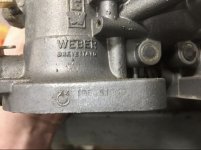Matthew68":13dnxihe said:
Thanks, X.
Should I be on the lookout for Weber 40s instead of 45s? Based on the charts and programs above, the calculations point to Weber 40s with a 33mm choke. Isn’t it true I can get the 45s in a 33mm choke as well?
As hard (and expensive) these DCOEs are, there seems to be much more 45s vs. 40s available.


Go for DCOE 45's if your using 33 venturis. Less than that 42DCOE's, which are ideal for 33 mm venturis. Maserati really did the most excellent work on DCOE's in the early 60's. 42 DCOE's aren't very common. In the USA, thankfully, 45DCOE's predominate, and thats just great because even a 2 liter Pinto runs better with 45s than 42's or 40's.
Biggest issue is the problem with the low venturi gospel. You
never want to downgrade venturi size unless the graphs for your cylinder size and rev range say you can. If you ignore the advice which streams from Edaurdo Webers WWII areo tests, and fall prey to the "it'll run better with smaller venturis" brigade, you'll be in for heartache.
An independent runner system on a 6 cylinder car (triple DCOE's) needs to have the venturi size exactly right for the application, and the carb size (40, 42, 45 or, gasp, 48DCO, 50DCO, 56DCO etc) has to fall in line with the venturi size.
Going down in venturi size if your DCOE45's come with, say, 38 or 40 mm venturis is fine though, if your 200 is only going to make power at 5000 rpm, and maybee over rev to 5500. 33's will run real nice everywhere in the rev range if the ignItion advance is as great as the carb tuning.
An example might be someone with a 300 cube six. They get some 42DCOE's and decide to stay with 36 mm venturis.
viewtopic.php?f=2&t=77685&p=608817#p608817
pmuller9":13dnxihe said:
....
If this 300 six makes peak power (maybe 250 hp) at 4500 rpm and will rev limit to 5000 rpm, what would the ideal venturi size be?
If the present Weber 45 DCOE with 36mm venturi are used at what point would you expect power to be sacrificed?
Thanks for your input.
For a 300 in line six, its 819 cc per cylinder.
I get 40 mm from the graph for power at 4550 rpm, Thats about the biggest venturi you can get in a DCOE45.
The calculation variable for 819 cc per cylinder is Critical Flow condition. An Air restrictor would be Venturi meter with Cd about 0.85.
As the venturi to carb size gets more divergent, the Cd figure goes down, becoming more streamlined, and you get a hp and torque gain from it.
http://www.performanceoriented.com/throttle-body-and-main-venturi-sizing/":13dnxihe said:
The following main venturi selection chart was generated using classical venturi sizing formulas and is based on a sizing coefficient of .80 for the venturi diameters. Additional tailoring of the formulas was performed to help fit the data to agree with actual OEM production and race engine configurations.
I took a risk and used PMO's copywrited material.
"Weber_pmo_derived" is the extrapolated result.
I get 43 mm at 5500 rpm, and the black line is for a 36 mm venturi on a 300 six, about 3600 rpm.
Way too low for a 300 cubic inch six with 819 cc per cylinder.
3600 rpm with the 36 mm venturi is a huge restriction to the elastic rev range required to run an IR system, and conventional US multiple carb logic doesn't work unless the air speeds are dropped.
CFM is a truley bad way of rating a multiple carb installation on a 300 cube six.
Although the flow losses of the 45 DCOE will flat line well below 36 mm, the losses between 38 to 40 mm are huge on a DCOE 45
Its better to find a set of DHLA 48's or 48DCO's or downdraft IDA 48's to get a better flow rate.
At the end, though, Aston Martins and Charger E49's used 40 mm venturis in DCOE 45's and they worked great on 314 to 325 hp 4 liter Hemi DOHC and 302 hp 265 cube Polyspheric OHV engines. The same thing happens with 38 to 40 mm venturis in 45 mm carbs, they become a lot more restrictive than 38 or 40 mm venturis in 48 or 50 mm carb bodies. Your loosing flow.
If your breaking the budget just to get an independent runner Triple Weber, then the only thing important is the venturi sizing. You can comprimise on air flow....Aston Martin and Chrysler Australia did, and those DB6'S, DBS's and Six Pack Chargers sang like Italian or Spanish tenors at 6000 rpm, 500 rpm past the point of maximum power. Because the venturis sizes were bang on, even if the carbs were techncially too small compared to some 48's or 50's. The extra cost in bigger Webers or Dell Ortos is just massive....
wsa111":13dnxihe said:
....
For your use don't waste money on the Webers.
Tuning the Holley or the Autolite parts availability is great.
*The best carbs aren't DCOE's but the much more rare down draft DCNF carbs used in V6's (Fiat Dino, Ferrari, Maserati, [early BiTurbos]) and quad carb quad cam V8's by Lamborghini, Ferrari, Lancia [Stratos], Maserati, Aston Martin. Some of them are just big enough internally to use on a 200-250 cube six and allow you to get a bigger venturi with "much less" space wastage. Space was at such a premium in those 60 and 90 degree quad cam engines with no space between the rocker covers. Aston Martin made a brace of routed out DCNF 48's for the 440 hp X pack Aston Martin V8 Vantages.
Frances 1976-1986 Simca 1307/1308 and Englands Chrysler and Talbot Alpine/ Solara briefly used them on the little 1294/1442/1594 cc Hemi headed OHV fours. And the twin carb 1600 cc version of the MG Maestro.
With the exception for the Countach, European Lotuses (um, Loti) and non injected Alfetta GTV's, DCOE's and Dell Orto DHLA's were ancient and absolete technology by 1979, and anyone copying them hasn't really thought through the costing verses space issues properly. Especially on a Falcon based unibody.
Retroject 38/38 Throttle Bodies
and Jenvey's DCNF TC body 40-45mm
[ TC42i TC body 42mm. DCNF - Bosch EV1 / EV6 (long 64mm between 'O' ring centres, 14mm boss)]
the above are much better bets.
Don't use ATB or Jenvey's ECM's, use a USA MegaSquirt computer, and see FOX Engineering Co, and save all the heat soak and tuning hassles, and forget all the sizing issues above.
About U$ 1200 for three 42 mm ITBs, aiming for 255 hp at 5800 rpm is very possible.
https://foxinjection.com/collections/dc ... tle-bodies
The guys there do it so simply
Basic ITB references for BHP per cylinder,
assuming a 5 inch from butterfly to valve head and a max of 9,000 rpm are;
Up to 30 BHP - 30mm, 180 hp six
up to 33 - 32mm, 198 hp six
up to 39 - 35mm, 234 hp six
up to 46 - 38mm, 276 hp six
up to 51 - 40mm, 306 hp six
up to 56 - 42mm, 336 hp six
Up to 65 - 45mm, 390hp six
up to 74 - 48mm, 444 hp six
up to 80 - 50mm, 480 hp six
up to 87 - 52mm, 522 hp six
up to 93 - 54mm, 558 hp six.























